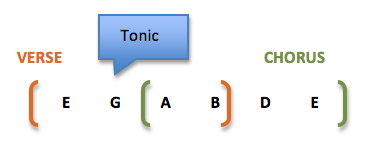It’s amazing how imaginative you can be using mainly pentatonic scales to create melodies. You might think that limiting yourself to 5 notes per octave means you’ve cut out a lot of possibilities, but that certainly doesn’t have to be the case.
If you haven’t done so yet, you might want to give Deerhunter’s new album, Fading Frontier, a listen. In particular, you can see the gorgeous possibilities of creating mainly pentatonic melodies in a song like the 3rd track,”Breaker.”
True, it’s not a melody that limits itself to pure pentatonic. By strict definition, a pentatonic scale means any 5 notes within an octave, but in common usage, a pentatonic scale usually means a major scale where the 4th and 7th notes are eliminated.
So if you’re using a pentatonic scale based on G, you’ll be using the notes: G A B D E.
In “Breaker”, they create a mainly pentatonic verse melody using just 3 of those notes, starting on a low E, and including G and B:
In the chorus, they maintain the same melodic shape, establishing a high note, swooping down, and then ending the phrase with a short upward gesture:
So all the important melodies of the song are derived from one octave of a pentatonic scale, where the verse focus on the lower half and the chorus on the upper half, overlapping in the middle:
The beauty of the music is in the production, and the strength of the musical structure lies in these overlapping pentatonic shapes.
If you’re interested in creating pentatonic melodies for your songs, here are some tips:
- Take a lesson from “Breaker.” Draw a pentatonic scale that encompasses at least an octave. Bracket a lower area that you’ll use as the notes for your verse, and then a higher area that you’ll use for your chorus. As in “Breaker”, it’s completely fine (and expected, actually) for these two areas to overlap.
- Don’t feel that you have to stick to a pentatonic scale for the entire song. You may want to use a more venturous note set for your verse, and then stick to something simpler (i.e., pentatonic) for the chorus. And certainly you can hear extra notes in “Breaker” that don’t belong to the G pentatonic scale.
- Experiment with minor pentatonic. We often think of pentatonic as having a mainly major sound, but you can create minor sounds with the exact same note set. To see what I mean, play a G major chord, and then sing or play a pentatonic scale above it. You’ll hear major. Now switch to an Em chord, and play the same scale. Suddenly, you hear minor. Use that to your advantage by perhaps using mainly minor chords in your verse, and major chords in your chorus.
Written by Gary Ewer. Follow Gary on Twitter
Check out “The Essential Secrets of Songwriting” eBook Bundle, along with a FREE DEAL.
















Hi Gary,
Can I assume this method of overlapping would also apply to a full scale, and not just the pentatonic?
Thanks for your wonderful, insightful blog!
Allison
Yes Allison, that’s right. Most songs will feature that kind of overlapping of verse and chorus ranges, even with full major or minor scales.
Very happy you like the blog, and thanks for writing!
-Gary